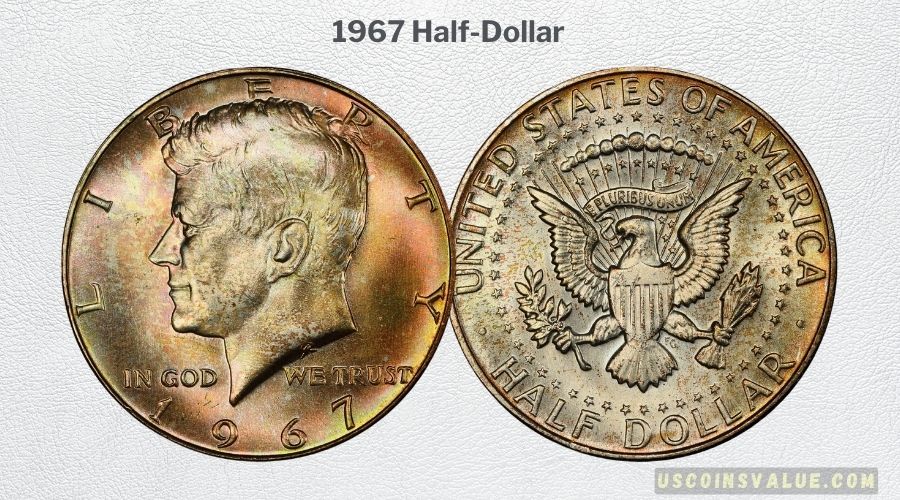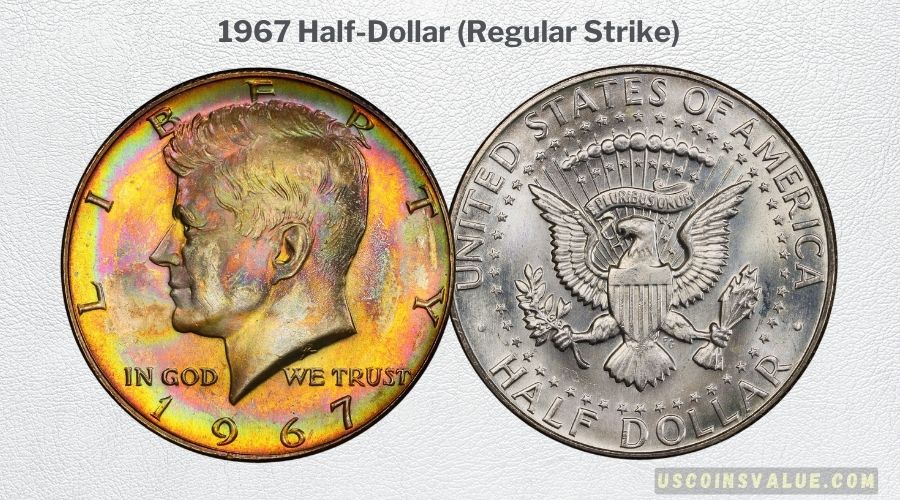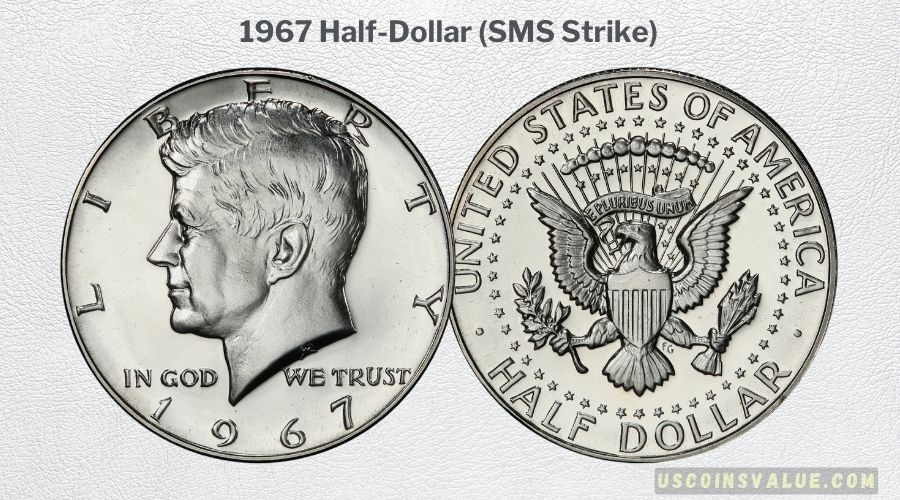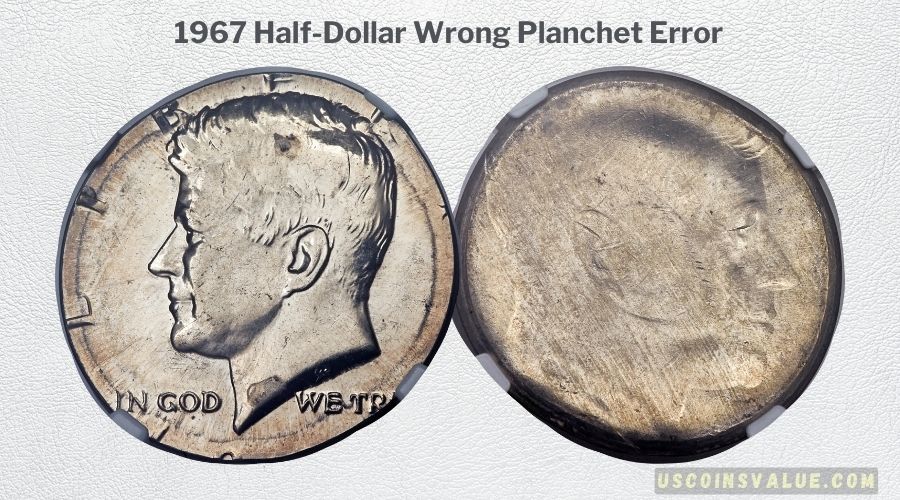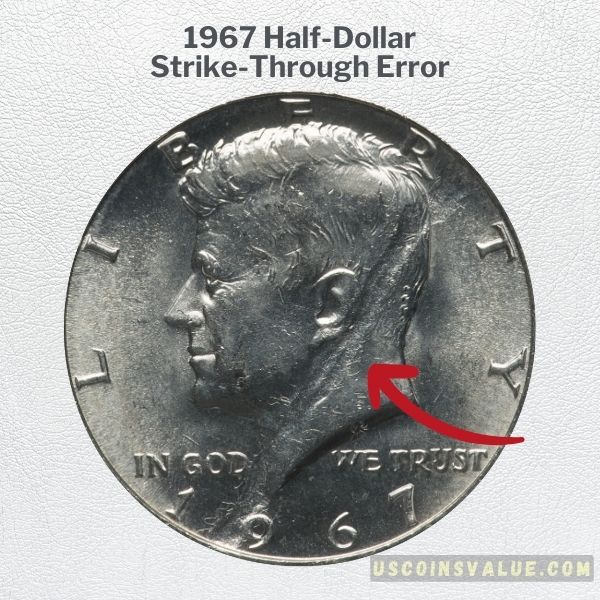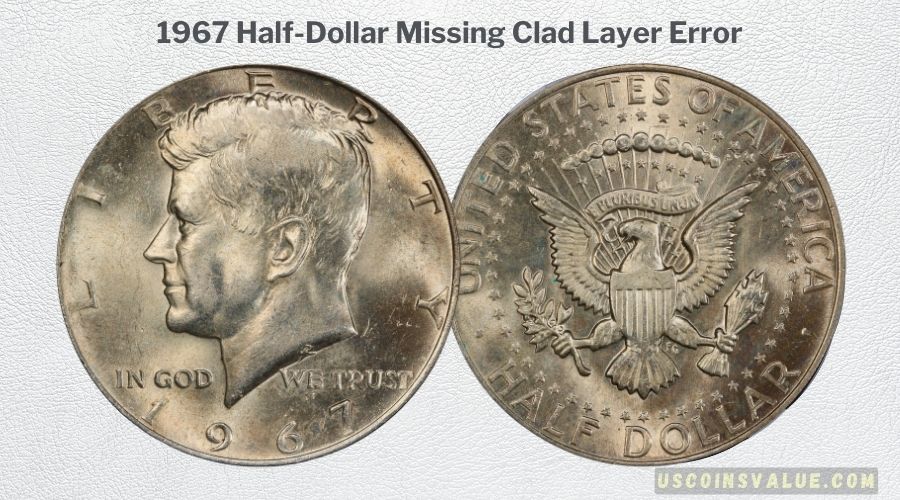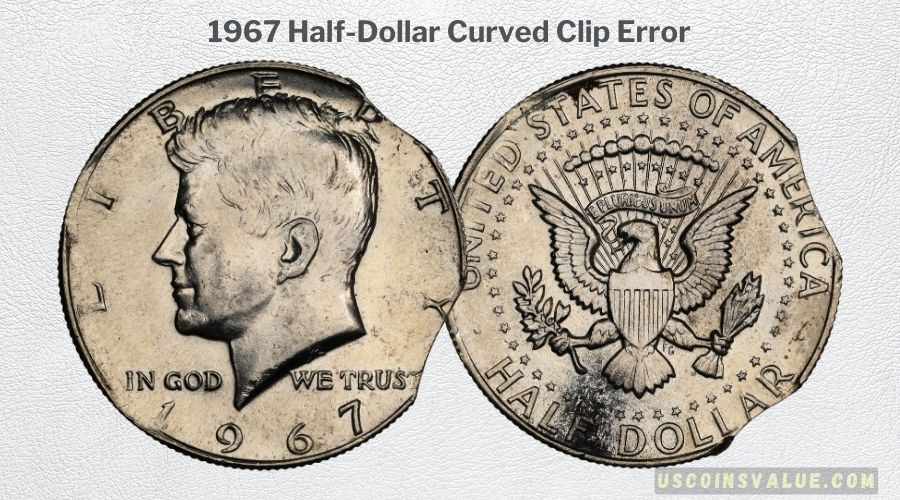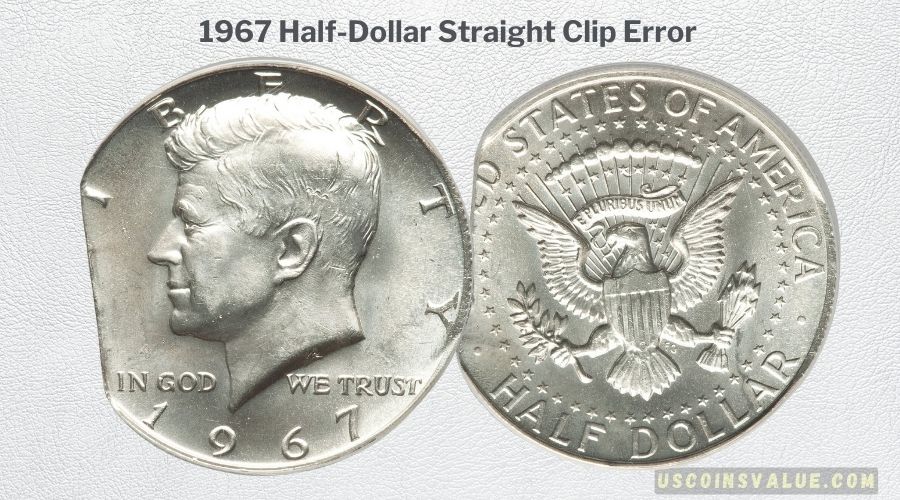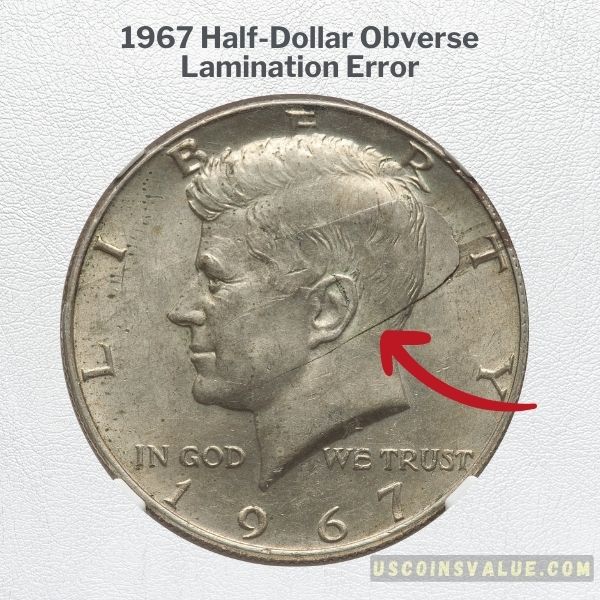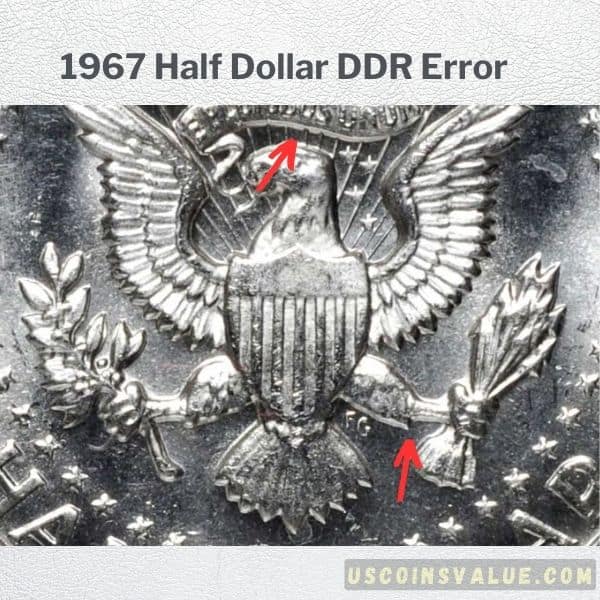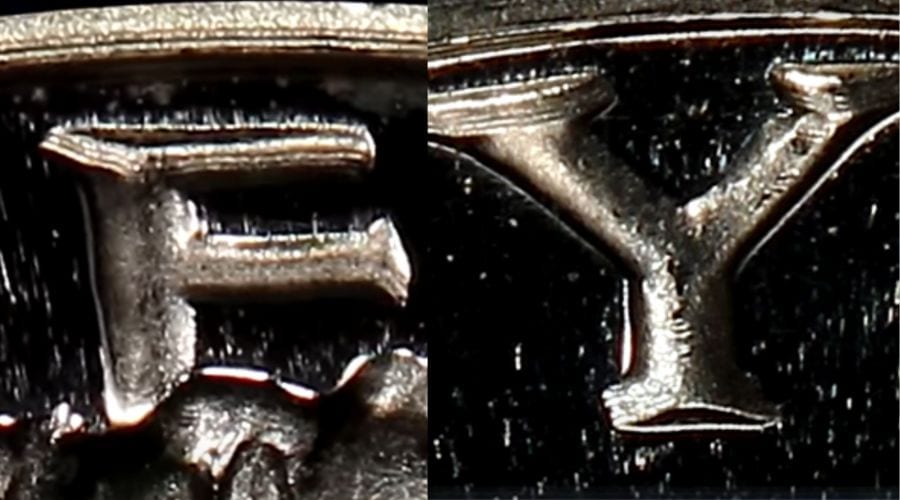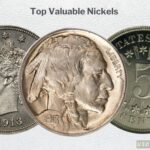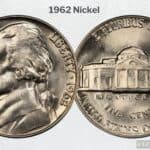Does the 1967 half-dollar command a high value in today’s coin market? Well, one of these coins sold for a record-breaking price of $31,200 in 2019. So, if you have one, hold on to it.
Today, a 1967 Kennedy half-dollar in average condition is worth $3.55 and about $87 or more in uncirculated mint condition.
However, these prices tend to fluctuate depending on factors like:
- Rarity: Rarity increases value, so rare 1967 half-dollars are pricey.
- Grade: Higher grades of MS66 and MS70 are worth between $215 and $5,750.
- Errors: 1967 half-dollar error coins are harder to find and, thus, more valuable.
Still wondering what exactly makes a 1967 half-dollar valuable? Stick around as we discuss the 1967 half-dollar value, history, and errors.
What is the Background of the 1967 Kennedy Half-Dollar?
- Series: Kennedy half-dollar
- Year of Make: 1967
- Mintage: 296,910,322
- Mint Branch: Philadelphia (no mint mark)
- Composition: 40% silver, 60% copper
- Weight: 11.5 grams
- Diameter: 30.6 millimeters
- Edge: Reeded (150 reeds)
Following the tragic assassination of John F. Kennedy, the nation was thrown into mourning, and Congress sought to commemorate the life of the deceased 35th president. So, they passed a bill to replace the Franklin half-dollar with a coin that depicted John F. Kennedy’s bust. This movement birthed the series of Kennedy half-dollar coins.
The Kennedy half-dollar coins were originally composed of 90% silver and 10% copper. However, rising silver prices, combined with the coin’s memorial sentiments created scarcity that led to hoarding.
To curb the hoarders, the U.S. Mint reduced the silver content of Kennedy half-dollars to 40% and placed a ban on mint marks between 1965 and 1967. So, 1967 half-dollars show no mint marks, have no proof varieties, and contain only 40% silver.
The ban did little to deter the Kennedy half-dollar coins from being hoarded, so it was lifted in 1967, and mint marks were reintroduced in the following year. As silver prices stabilized years later, some hoarded coins were released, only a little were worth more than face value.
So, 1967 half-dollar coins bear no mint marks and are still difficult to find in circulation today.
What Does the 1967 Half-Dollar Look Like?
The obverse of the 1967 half-dollar shows a bust of John F. Kennedy designed by Gilroy Roberts, who had initially created the portrait for the U.S. Mint’s presidential medal series.
John F. Kennedy’s portrait is in the left profile, and the ex-president appears to have a small smile. His curly hair is also cut short, but the bust features no further adornments. The inscriptions on this side include:
- LIBERTY
- IN GOD WE TRUST
Designed by Frank Gasparro, the 1967 half-dollar’s reverse was based on a pre-existing design. It depicts the iconic presidential seal of the heraldic eagle and shield.
The eagle clutches a bunch of arrows in its left talons and an olive branch in its right. The image of the eagle is surrounded by stars in a circle, representing the various states. The obverse also shows these inscriptions:
- UNITED STATES OF AMERICA
- E PLURIBUS UNUM
- HALF-DOLLAR
- FG
Due to the mintmark ban in 1967, the U.S. Mint produced no proof varieties for the 1967 half-dollar. However, the Mint produced a Special Mint Set (SMS) that coin collectors could still add to their collection. Here’s a brief overview of these two varieties and mintage:
| 1967 (Kennedy half-dollar) Varieties | Composition | Mint Location | Mintage |
| 1967 Regular Strike | 40% silver, 60% copper | Philadelphia (No mint mark) | 295,046,978 |
| 1967 SMS Strike | 40% silver, 60% copper | Philadelphia (No mint mark) | 1,863,344 |
1. 1967 Half-Dollar (Regular Strike)
The 1967 half-dollar regular strike was minted in high numbers. This coin is made of silver and copper, with a metal composition of 0.1479 t oz.
Its high silver content caught the eye of hoarders, who would either melt it down or collect it for future use. Regardless of its high mintage, you’d have to search well enough to land one of these coins in good condition.
2. 1967 Half-Dollar (SMS Strike)
Like proof varieties, the 1967 half-dollar SMS strike varieties are valued higher than regular strikes due to their special finishes). They’re shinier, more attractive, and instant eye-catchers.
Over 1.8 million half-dollar SMS strike varieties were produced in 1967. So, many of these coins were in circulation, even with the hoarding.
The SMS Strikes were struck in Cameo (CAM) and Deep Cameo (DCAM) finishes, creating beautiful coins that could still serve as worthy collectibles.
What is the 1967 Kennedy Half-Dollar Value?
Even decades after its original mint date, the 1967 Kennedy half-dollar is still a valuable coin. Lower grades between PrAg and XF are valued at $3.55, while MS67+ grades are valued at $5,750.
The most common and less valuable grades of the 1967 half-dollar coins are all circulated grades up to MS63.
Grades like MS65, MS66, and above are more challenging to come across, with only a few hundred pieces still in circulation. So, these grades are more likely to bring in more money as they are worth between $3,150 and $5,750 or more. Here’s a quick value chart for you.
| 1967 half-dollar (MS/SMS) | 1967 half-dollar (Regular Strike) | 1967 half-dollar (SMS Strike) |
| 60 – 63 | $5.25 – $8 | $4 – $7.50 |
| 64 – 65 | $15 – $75 | $15 |
| 65 – 66 | $55 – $440 | $15 – $35 |
| 67 | $3,150 – $5,750 | $57 – $100 |
| 68 – 69 | – | $320 – $860 |
1. 1967 Kennedy Half-Dollar (Regular Strike)
With over 295 million 1967 half-dollars minted in regular strikes, these coins can be fairly easy to find today but don’t expect to find many of them in mint state.
They were hoarded right from the start, so 1967 Kennedy half-dollar coins in pristine conditions are hard to come by.
As of today, the highest 1967 Kennedy half-dollar grades in this category range between MS67+ and MS68 and are valued at $5,750. But barely three years ago, a 1967 Kennedy half-dollar sold for $6,995 in grade SMS MS68
Look out for high grades like SMS MS 67+ and above, especially those in Ultra Deep Cameo finish. They are lustrous coins with near-perfect finishes, retaining most of their original frosted designs.
Don’t be quick to assume your coin is worth thousands though. In November 2023, a 1967 Kennedy half-dollar went for only $15 at MS65 on eBay. At a Stack’s Bowers auction, a higher grade of MS67 sold for $780 in July 2023.
Due to this coin’s high mintage, even high grades like MS67 and MS68 may not be worth much except in highly pristine conditions. Here’s a brief overview of its highest sale prices.
| Grade | Highest Price & Sale Date | Firm |
| MS68 | $6,995 (2020) | eBay |
| MS67+ | $4,348 (2016) | Heritage Auctions |
| MS67 | $4,230 (2016) | Heritage Auctions |
| MS67 | $3,525 (2015) | Heritage Auctions |
| MS67 | $4,025 (2012) | Heritage Auctions |
2. 1967 Half-Dollar (SMS Strike)
You’re more likely to find special mint set coins in pristine condition than regular strike coins. This is because SMS coins were struck solely for collectors. If you can find one in either a cameo or deep cameo finish with strong contrasts, collectors can be willing to pay thousands of dollars.
In 2019, Heritage Auctions sold a 1967 half-dollar graded SP69DCAM for a whopping price of $31,200. The same auction firm also sold a 1967 half-dollar in grade SP68 for just $139 in July 2023, because coins because SP68 grades are valued lower than SP69.
As such, keep an eye out for coins in grade SP69 or higher, especially those with CAM or DCAM finishes, as they are more valuable.
More recently, the 1967 half-dollar has sold between $75 and $3,600 in 2023. Take a look at some of the highest prices and sale dates.
| Grade | Highest Price & Sale Date | Firm |
| SP69DCAM | $31,200 (2019) | Heritage Auctions |
| SP69DC | $19,975 (2016) | Heritage Auctions |
| SP68 | $17,625 (2015) | Heritage Auctions |
| SP69DC | $15,600 (2017) | Heritage Auctions |
| SP69DCAM | $12,600 (2018) | Stack’s Bowers |
Common Errors in the 1967 Kennedy Half-Dollar
Your collection of historical coins may not be complete until you throw in some error coins. Error coins make coin collections even more interesting, adding rarity and uniqueness to a collection.
Like most collectibles, the 1967 Kennedy half-dollar exists in some errors you may find worthy enough to keep.
1. Wrong Planchet Error
The process of minting coins isn’t always seamless. Sometimes, the planchet intended for a particular denomination can be used to strike another coin unintentionally. This results in the wrong planchet error.
A 1967 Kennedy half-dollar struck on a five-cent planchet sold for as high as $2,820 in 2017 at an NGC Auction. A few years before that, a 1967 half-dollar coin with this error sold for $747.50 in 2010.
2. Strike-Through Error
A “perfect” coin is produced when the die meets the planchet, with no foreign materials between the two surfaces. If an object interrupts the striking process, it could leave a mark on the coin’s surface, producing the strike-through error.
Earlier this year, in June 2023, a 1967 Kennedy half-dollar with this error sold for $149, while another sold for $159 in January 2023.
3. Missing Clad Layer Error
If a coin is produced from different metal composites, it will have several layers due to the differences in composition. However, if one or more layers are missing, the coin will appear smaller and weigh less than regular coins.
In 2022, a 1967 Kennedy half-dollar with a missing clad layer sold for $124. The year before, another one of these error coins sold for $134 at grade MS64.
4. Curved & Straight Clip Error
If your coin features a straight edge or looks like a crescent moon, it’s a result of the curved or straight clip error. This error occurs when the planchet is tampered with during striking, leading to irregular edges.
A 1967 half-dollar with a curved clip error sold for $50 in 2022 and $85 in 2023. On the other hand, collectors will usually pay around $61 to $79 for a straight clip error coin, depending on the grade.
5. Obverse Lamination Error
When impurities get trapped inside the planchet during the striking process, that part of the coin starts to chip away after some time. This is known as the lamination error.
1967 half-dollars with lamination errors are worth between $39 and $99, or even more, depending on their grades.
6. The Double Die Reverse
Same as the Double die obverse but on the reverse side. A DDR error is most easily noticeable on the stars surrounding the Presidential Seal although you’ll usually still need a magnifying glass.
A DDR error half dollar sold for just $9.99 because of its low grade. However, in 2021, the same error sold for $192 as it’s graded as MS65.
7. Quintuple Die Obverse
A very rare error was found on some 1967 SMS half dollars. As the name suggests, this happens when the obverse has quintupled into five slightly distorted images.
Some say there are coins sextupled (six images) but that’s debatable as the differences are very slight and a microscope is needed.
For example, an MS66 half dollar from 1967 that has the QDO error is sold for $179.99 on eBay.
Final Thoughts
The 1967 Kennedy half-dollar represents an interesting piece of American history that makes it dear to numismatists everywhere.
Its silver composition makes it highly sought-after, and although grades like SP69DAM are extremely rare, they can fetch you up to $31,000 or more.
If you find a 1967 Kennedy half-dollar worth keeping, don’t try to evaluate it yourself. Send it to professional coin grading companies, and they’ll let you know if you have a gem on your hands or not.

